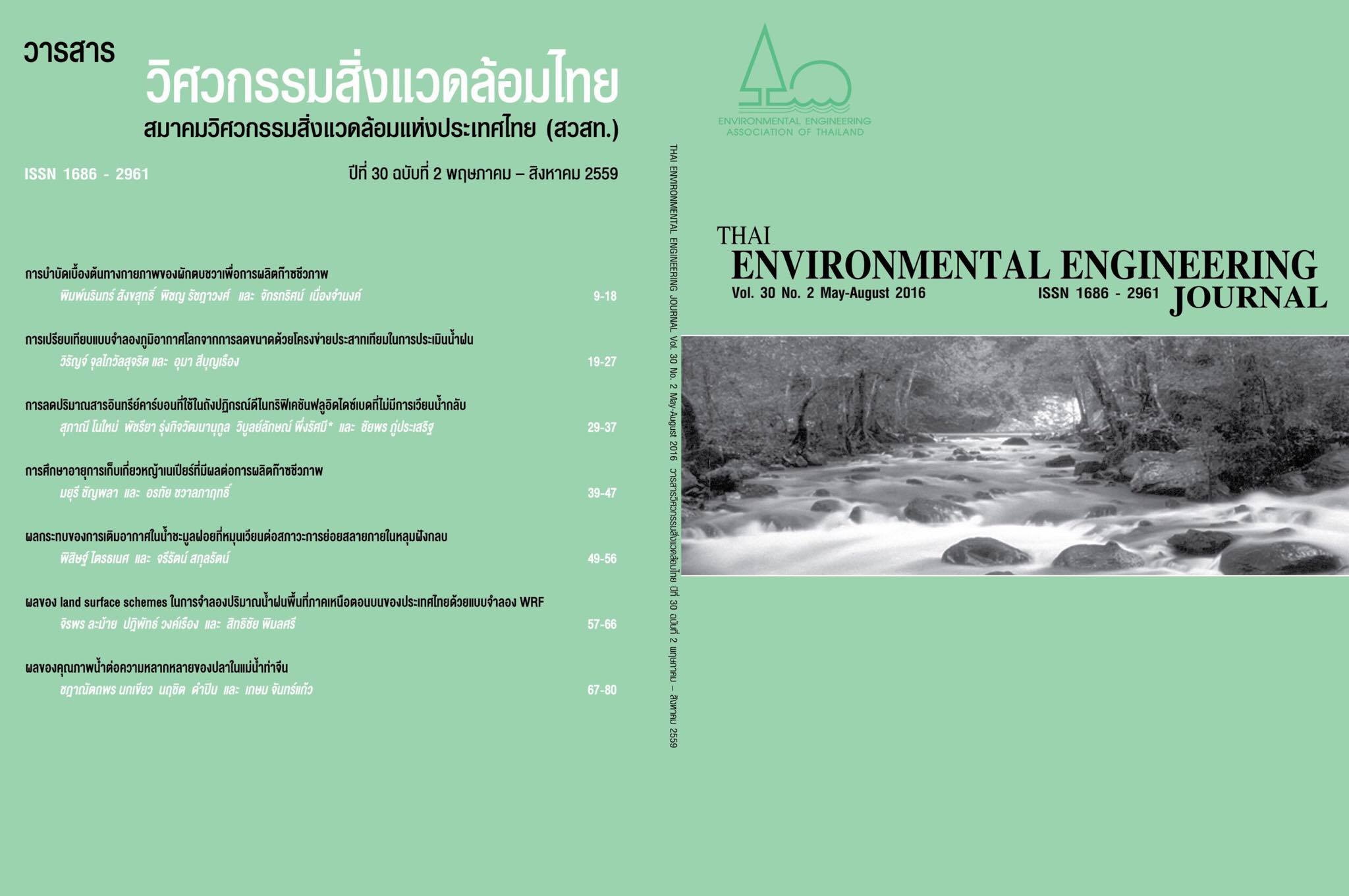Study of Napier Grass Harvesting Age Influencing on Biogas Production
Main Article Content
Abstract
This work was aimed to study the effect of Napier grass (Pak Chong 1) harvesting age on biomass characteristics and biogas production potential. Anaerobic batch digestions were conducted in 125 mL-serum vials using cow manure as seed and varying grass maturity at harvesting ages of 35, 45 and 55 days, respectively. The chemical characteristics by means of compositional changes at each maturity were compared as well as biogas production potential. The results depicted that the different harvesting age of Napier grass promoted the different chemical characteristics particularly total solid, lignin content and C/N ratio. The digestions of Napier grass found that the highest biogas productivity of 208 L/kgVSadded was obtained for Napier grass harvested at 45 days compared to
111 and 83 L/kgVSadded for age of 35 and 55 days, respectively, Additionally, Napier grass at harvesting age of 45 and 55 days contained the proper composition in terms of C/N ratio which expected to exhibit better digestibility.
However, at 55 days harvested, the grass biomass contained more concentration of retarding fraction such as lignin for approximately 6.09%. The increase in fiber components and decrease in digestibility with advanced harvesting date had a negative impact on the specific methane yield and this impact was similar across the Napier grass. The result demonstrated clearly the important of Napier grass harvesting age on biomass characteristics and its influence on biogas production potential. Therefore, harvesting age of grass is a key consideration factor in biogas plant operation form grass biomethanation.
Article Details
References
[2] Rengsirikul, K., Ishii, Y., Kangvansaichol, K., Pripanapong, P., Sripichitt, P., Punsuvon, V., Vaithanomsat, P., Nakamanee, G. and Tudsri, S. 2011. Effect of inter-cutting interval on biomass yield, growth components and chemical composition of napiergrass (Pennisetum purpureum Schumach) cultivars as bioenergy crops in Thailand. Grassl Sci. 57: 135-141.
[2] Rengsirikul, K., Ishii, Y., Kangvansaichol, K., Sripichitt, P., Punsuvon, V., Vaithanomsat, P., Nakamanee, G. and Tudsri, S. 2013. Biomass yields, chemical composition and potential ethanol yields of 8 cultivars of Napier grass (Pennisetum purpureum Schumach.) harvested 3-monthly in central Thailand. J Sust bioenergy Syst, 3: 107-112.
[3] Bach, EE., Alcaˆntara, VBG., Alcaˆntara, PB. and Veasey, EA. 1995. Biochemical and isoenzyme analyses of elephant grass, Pennistum purpureum (SCHUM) varieties. Sci Agric. 52: 528-533.
[4] Queiroz, FJL., Da Silva, DS. and Do Nascimento, IS. 2000. Dry matter production and quality of elephant grass (Pennisetum purpureum Schum.) cultivar Roxo at different cutting ages. R Bras Zootec. 29: 69-74.
[5] Charapaka, N. 2011. Biochemical methane potential of grass species. Department of environmental engineering, Faculty of engineering, Chulalongkorn University.
[6] Kanjana, W. 2012. Enhancement of biogas production from pretreatment napiergrass by completely stirred tank Reactor. Department of environmental engineering, Faculty of engineering, Chulalongkorn University.
[7] Janejadkarn, A. 2014. Biogas production from napier Grass (Pak Chong 1) (Pennisetum purpureum × Pennisetum americanum). Department of environmental engineering, Faculty of engineering, Chulalongkorn University.
[8] Elsaber, M., Keymer, U. and Robberg, R. 2012. Biogas from grass. DLG Expert Knowledge Series. 386.
[9] APHA, AWWA and WPCF. 2005. Standard methods for the examination of water and wastewater. 20Th Edition.
[10] Van Soest, P.J. 1963. Use of detergents in the analysis of fibrous feeds. II. A rapid method for the determination of fibre and lignin. AOAC. 46: 829-835.
[11] Owens, J. M. and Chynoweth. 1993. Biochemical methane potential of municipal solid waste (MSW) components. Wat. Sci. Tech. Vol. 27: 1-14.
[12] Tudsri, S., Sukaket, S. and Pookpakdi, A. 1996. Dry matter production and quality of some tropical grasses. Kasetsat J (Nat. Sci.) 30(3): 293-302.
[13] Pipat Lounglawan, Wassana Lounglawan and Wisitiporn Suksombat. 2014. Effect of cutting interval and cutting height on yield and chemical composition of King Napier grass (Pennisetum purpureum x Pennisetum americanum). Procedia APCBEE. 8: 27-31.
[14] Ramano, R. T. and Zhang, R. H. 2008. Co-digestion of onion juice and wastewater sludge using an anaerobic mixed biofilm reactor. 99(3): 631-637.
[15] Zhu, J. and Li, Y. 2009. Experimental study on solid state anaerobic digestion of organic waste for methane production. In proceedings of the 2009 annual ASABE meeting 2009.
[16] Promma, F., Thanaboripat, D. and Sirirote, P. 2015. Biogas production from 3 strains of Napier grass (Pennisetum purpureum). KM ITL Sci Technol J. 23(2): 30-50.


